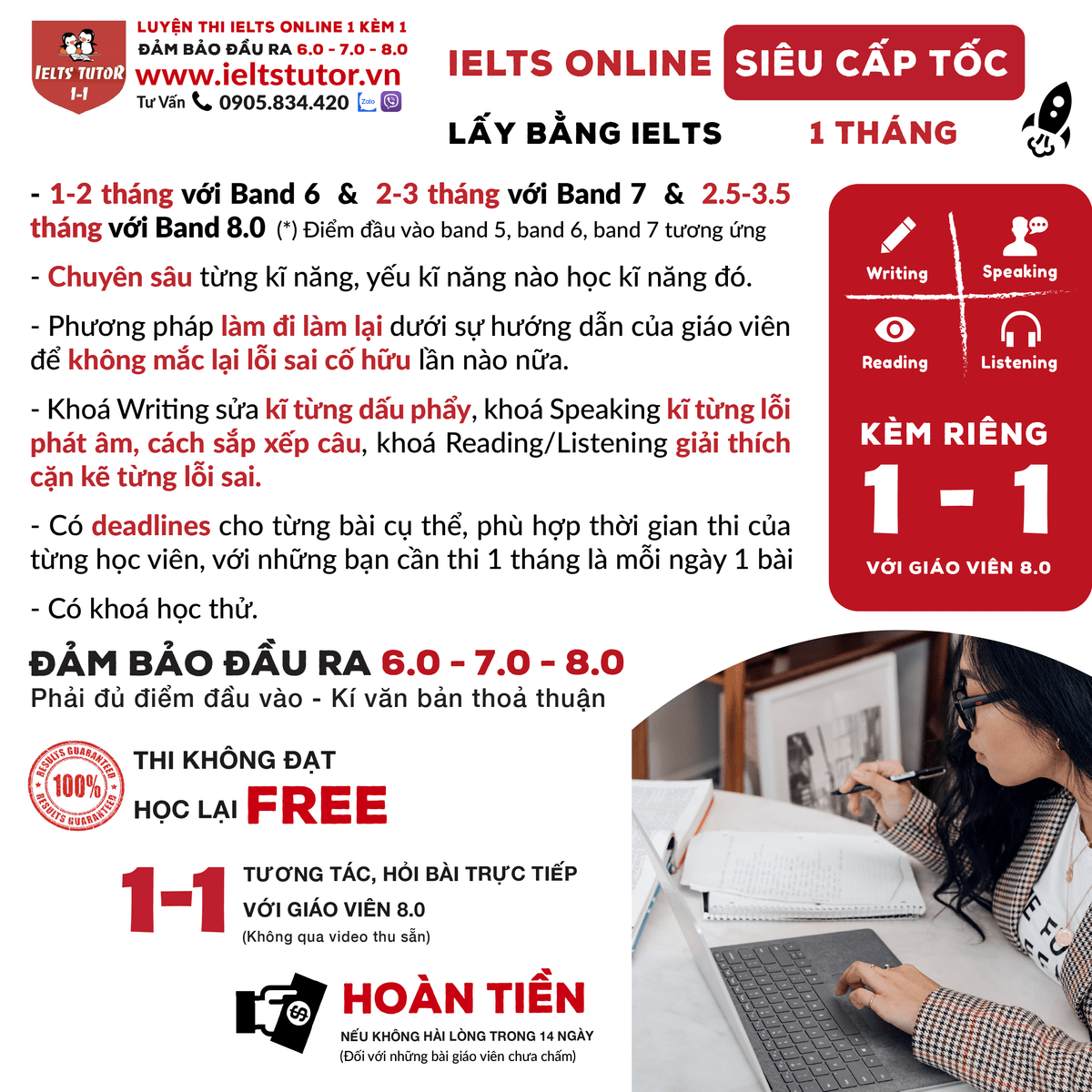IELTS TUTOR cung cấp 🔥From princes to paupers: how Goya's portraits tell the story of Spain Answers with location - Đề luyện IELTS READING- Làm bài online format computer-based, kèm đáp án, dịch & giải thích từ vựng - cấu trúc ngữ pháp khó
I. Kiến thức liên quan
II. Làm bài online (kéo xuống cuối bài blog để xem giải thích từ vựng & cấu trúc cụ thể hơn)
📩 MN AI CHƯA CÓ ĐÁP ÁN FORECAST QUÝ MỚI PART 1-2-3 NHẮN ZL 0905834420 IELTS TUTOR GỬI FREE HẾT NHA
III. From princes to paupers: how Goya's portraits tell the story of Spain: Đề luyện IELTS READING (IELTS Reading Practice Test)
READING PASSAGE 2
You should spend about 20 minutes on Questions 14-26, which are based on Reading Passage 2 below.
From princes to paupers: how Goya's portraits tell the story of Spain
A There are, according to current scholarship, 160 existing portraits by Francisco de Goya - about a third of his painted output. The real number, though, is much greater since there are no pure landscapes in Goya's work, in that everything he ever painted deals with people. In the work of no other great portraitist are a nation's people, history, traumas, folk traditions, and superstitions so comprehensively and relentlessly captured. His subject was a good one since Goya lived in interesting times: his lifetime was a period that saw Spain pass through the effects of the French Revolution, the Napoleonic wars, and the restoration of the monarchy; it was ruled by a succession of authoritarian and liberal governments; and was simultaneously marked by the Enlightenment. Put his work together - the public and private paintings, the personal drawings and sketches, and the unsettling and sinister etching series - and what you have is a portrait in the round of Spain itself.
B His work as a portraitist has its origins in the 45 tapestry cartoons he painted after he moved to Madrid in 1775. Although his designs don't show portraits, they do show types - the majos and majas who gave Madrid its street swagger, peasants and rich men, courting couples, singers, hunters, children, and young men and women playing blind man's buff or tossing a mannequin into the air. The pictures have a light, rococo palette and the faces are individualised without being those of individuals. But in them, Goya practised poses and groupings and a way of handling light on and around figures that was to be invaluable.
C The tapestry designs also show social roles rather than the people inhabiting them, but when it came to painting portraits proper, Goya would turn this on its head. His greatest strength as a portraitist is that regardless of the status of the sitter, be they a king and queen, the Duke of Wellington, or a doctor or writer, it was the person he showed first and their position second. It was this trait, most apparent in his royal portraiture, that has led him to be seen as satirising the Bourbon monarchy rather than as a painter who depicted what he saw without showing obeisance to the usual flattering conventions. In Robert Hughes's phrase, he did not 'pay reflexive homage to authority' but instead walked a fine line between respect and truth.>> Form đăng kí giải đề thi thật IELTS 4 kĩ năng kèm bài giải bộ đề 100 đề PART 2 IELTS SPEAKING quý đang thi (update hàng tuần) từ IELTS TUTOR
D Goya's success was rapid; in 1785 he was made deputy director of painting at the Royal Academy (his main message to his students was subversive - 'there are no rules in painting') and in 1786 became pintor de cámara, required to paint 'works required for royal service'. He immediately spent some of his 15,000-reales salary on a two-wheeled gig (one of only three in Madrid) which he promptly crashed on his first outing. His amour propre untouched, he wrote to his childhood friend Martín Zapater: 'I have now established an enviable way of living: I do not wait on anyone in antechambers, and if anyone wants anything from me they must come to me; I have made myself more in demand and unless it is a person of rank or at the request of a friend I would do nothing for anyone...'
E Part of the reason for his success was that, unlike Gainsborough, for example, he did not resent portraiture as an economically necessary chore that ate away at the time he could devote to higher art. He embraced the genre as a means of exploring human character. This genuine interest allowed him to penetrate the facade of his sitters, capturing not just their likeness but their psychological state. His portraits from the 1790s, particularly of the royal family, are masterclasses in this approach. He presented them with a stark realism that was unprecedented, grouping them in a way that highlighted their familial dynamics and individual personalities, however flawed or ordinary they might appear.
F This commitment to psychological truth became even more pronounced following his near-fatal illness in 1793, which left him deaf. Isolated from the world of sound, Goya’s focus turned inwards, and his work grew darker and more introspective. The light rococo tones of his tapestry cartoons gave way to a richer, somber palette and a dramatic use of chiaroscuro. His portraits from this period, such as those of the Duchess of Alba, are charged with a complex mixture of intimacy, mystery, and power. The line between observer and subject seemed to dissolve, as Goya used the portrait not for public glorification but as a form of private, almost philosophical, inquiry.
G Ultimately, Goya’s career traces the arc of Spain’s tumultuous age. The enlightened optimism of his early court paintings gradually soured into a profound disillusionment, vividly recorded in his later, so-called 'Black Paintings'. These murals, painted directly onto the walls of his country house, are a far cry from the formal portraits of princes and dukes. They depict haunting, mythological scenes and grotesque figures, reflecting the despair and chaos of a nation ravaged by war and repression. In this final phase, the portrait of Spain was no longer found in the faces of individuals, but in the tormented soul of its people.
Questions 14-26
Questions 14-19
The reading passage has seven paragraphs, A-G.
Which paragraph contains the following information?
Write the correct letter, A-G, in boxes 14-19 on your answer sheet.
NB You may use any letter more than once.
A description of a personal purchase that ended in an accident.
The reason why Goya’s body of work provides such a complete representation of his country.
A contrast between Goya's early work and his later, more mature style.
An explanation of why Goya was able to be so successful as a portrait painter.
Reference to a specific artistic technique that Goya developed in his early career.
The claim that Goya’s final works moved away from depicting specific people.>> IELTS TUTOR gợi ý tham khảo CẦN VIẾT & THU ÂM BAO NHIÊU BÀI ĐỂ ĐẠT 8.0 SPEAKING & 7.0 WRITING?
Questions 20-22
Complete the summary below.
Choose NO MORE THAN TWO WORDS from the passage for each answer.
Write your answers in boxes 20-22 on your answer sheet.
Goya's Tapestry Cartoons
Before becoming a renowned portraitist, Goya created designs for tapestries after moving to Madrid. These cartoons did not feature true 20 ......................., but instead depicted various social 21 ....................... . The artistic style of these works was light and rococo, and while the faces were distinctive, they were not of specific, identifiable people. However, these early projects were crucial as they allowed Goya to practise arranging figures and mastering the effect of 22 ....................... on his subjects.
Questions 23-26
Do the following statements agree with the information given in Reading Passage 2?
In boxes 23-26 on your answer sheet, write
TRUE if the statement agrees with the information
FALSE if the statement contradicts the information
NOT GIVEN if there is no information on this
Goya believed that his teaching role at the Royal Academy was more important than his work for the royal family.
Robert Hughes believed that Goya balanced respect and truth in his portraits of authority figures.
Goya's illness directly caused him to change his subject matter from portraits to landscapes.
The 'Black Paintings' were originally intended for public display.
IV. Dịch bài đọc From princes to paupers: how Goya's portraits tell the story of Spain
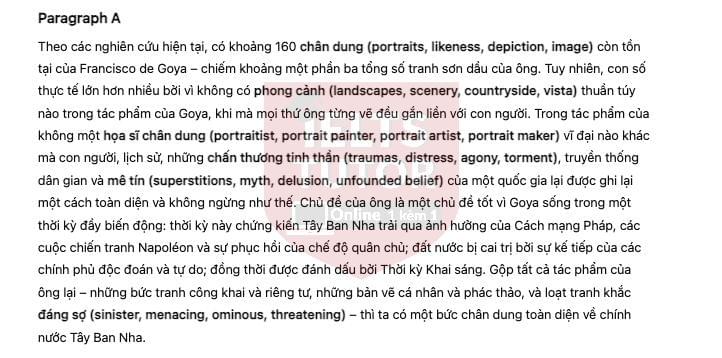
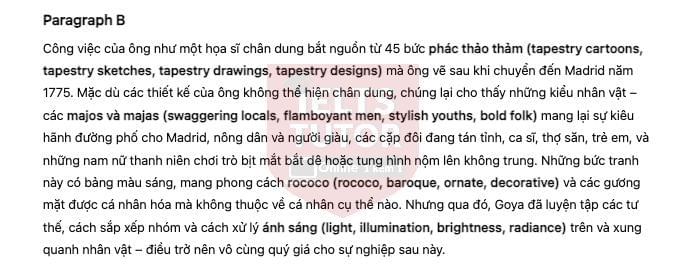
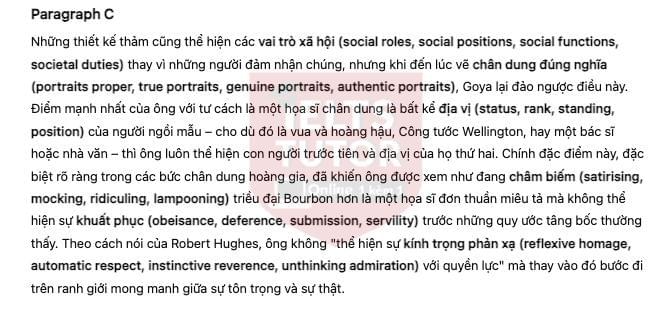
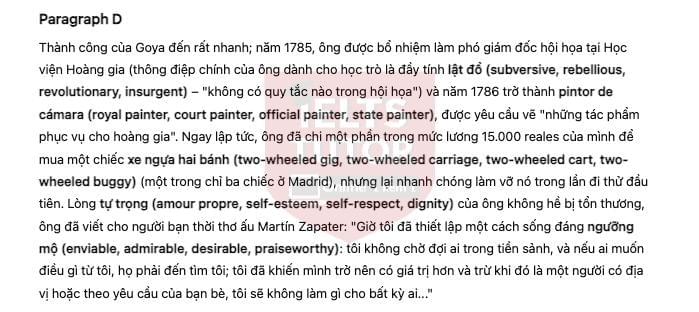
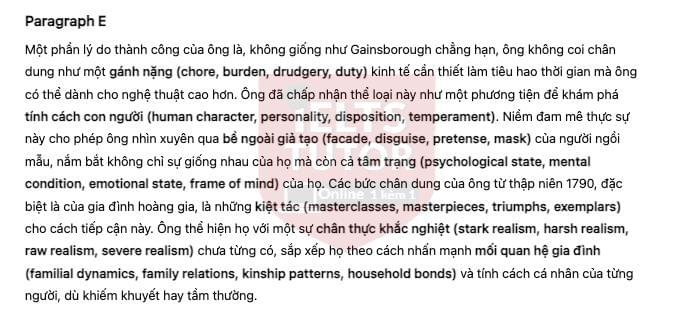
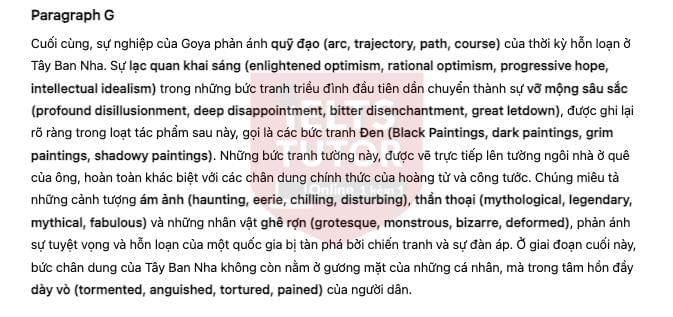
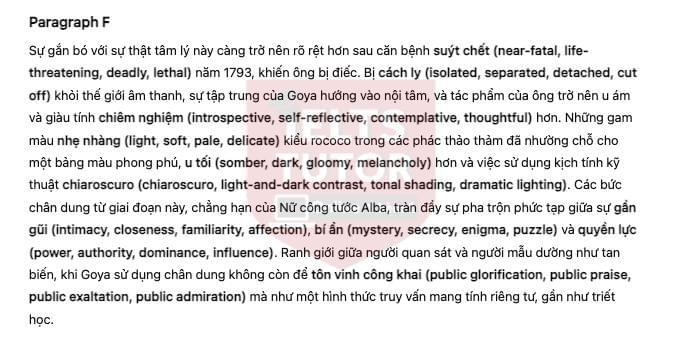
V. Giải thích từ vựng From princes to paupers: how Goya's portraits tell the story of Spain
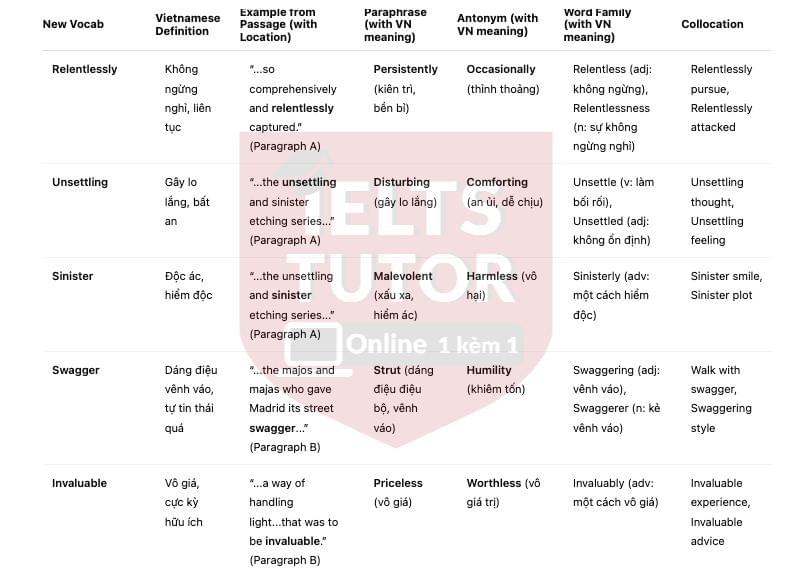
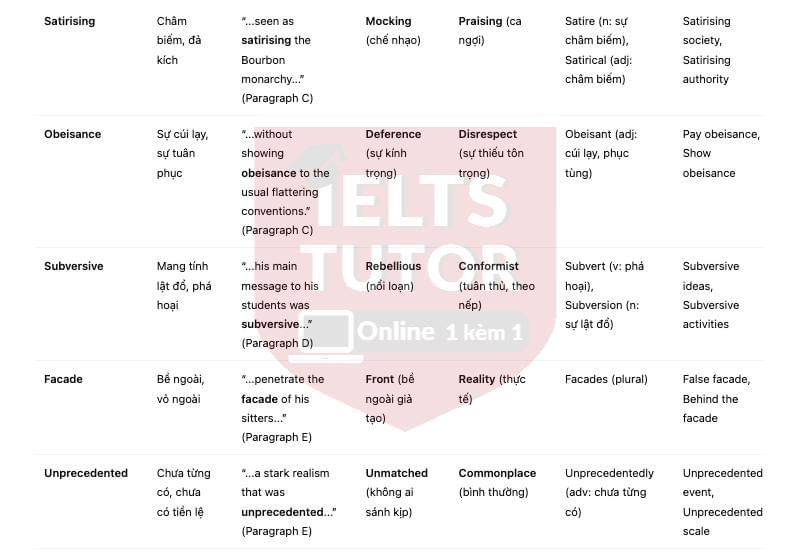
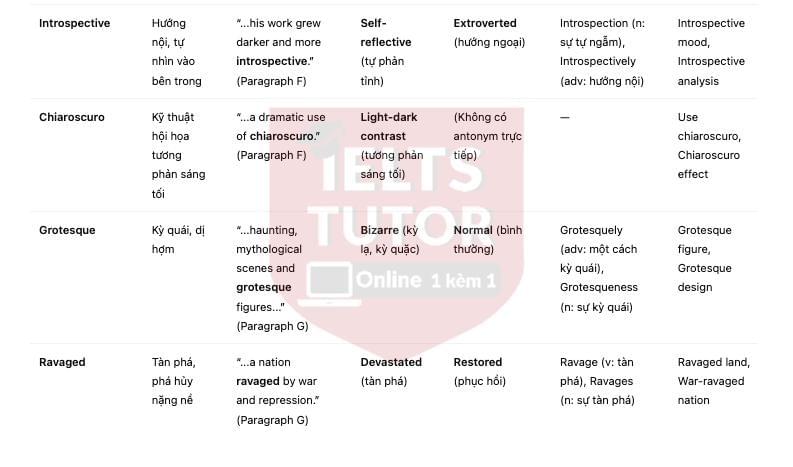
VI. Giải thích cấu trúc ngữ pháp khó From princes to paupers: how Goya's portraits tell the story of Spain
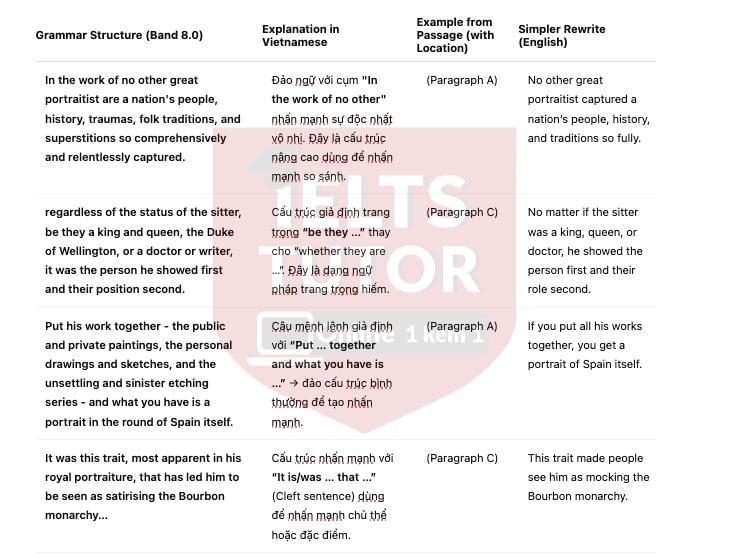
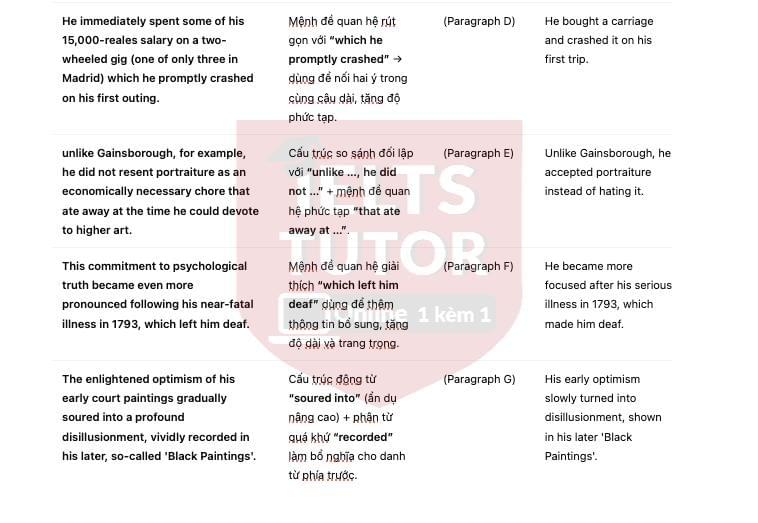
VII. Đáp án From princes to paupers: how Goya's portraits tell the story of Spain
Questions 14–19
D
A
F
E
B
G
Questions 20–22
portraits
roles
light
Questions 23–26
FALSE
TRUE
FALSE
FALSE
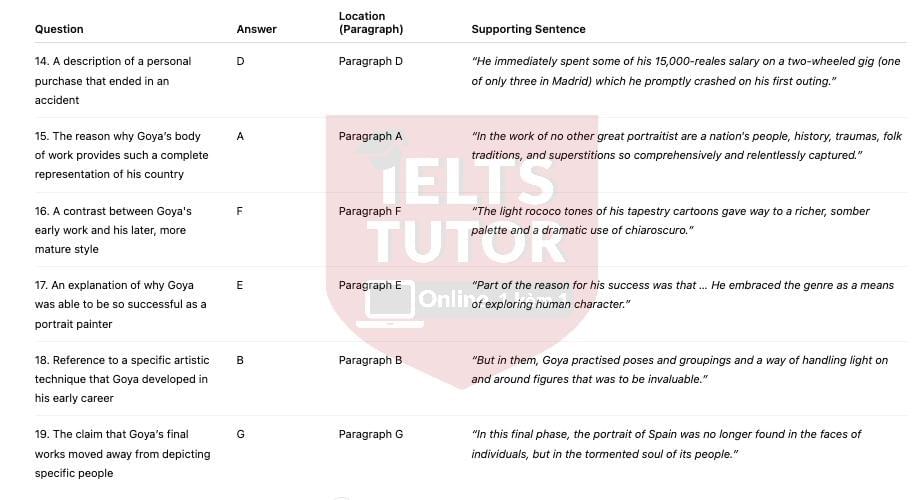
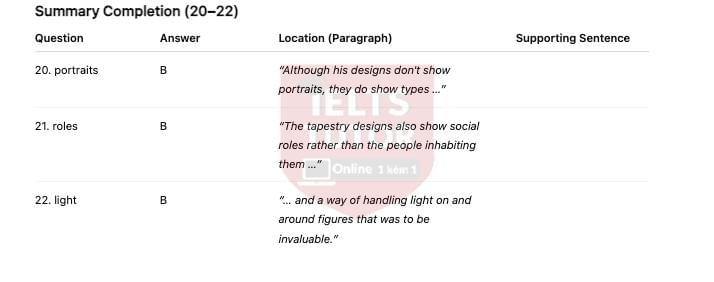
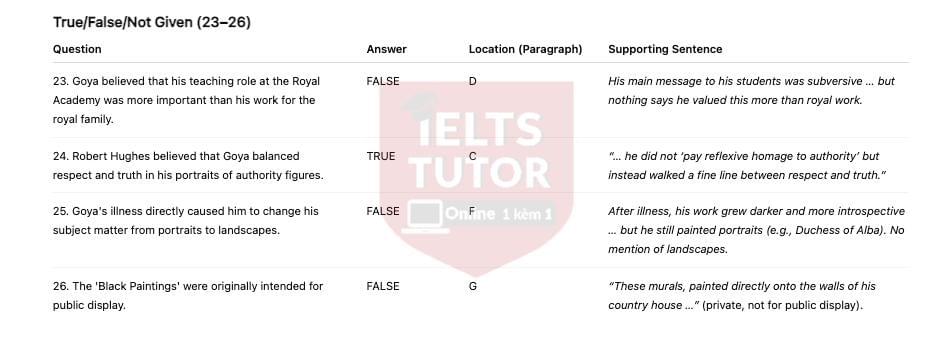
📩 MN AI CHƯA CÓ ĐÁP ÁN FORECAST QUÝ MỚI PART 1-2-3 NHẮN ZL 0905834420 IELTS TUTOR GỬI FREE HẾT NHA

Các khóa học IELTS online 1 kèm 1 - 100% cam kết đạt target 6.0 - 7.0 - 8.0 - Đảm bảo đầu ra - Thi không đạt, học lại FREE
>> Thành tích học sinh IELTS TUTOR với hàng ngàn feedback được cập nhật hàng ngày
